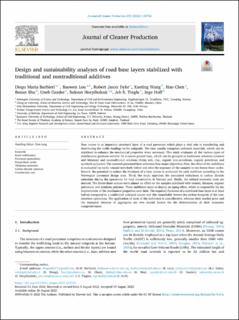| dc.description.abstract | Base course is an important structural layer of a road pavement which plays a vital role in transferring and distributing the traffic loadings to the subgrade. The base usually comprises unbound materials, which can be stabilized to enhance the mechanical properties when necessary. This study evaluates all the various types of stabilization products suitable for a coarse-graded base, which can be grouped as traditional solutions (cement and bitumen) and nontraditional solutions (brine salt, clay, organic non-petroleum, organic petroleum and synthetic polymer). The research presented here addresses four major objectives. First, the effect of the stabilizers is evaluated via cyclic triaxial tests both before and after the exposure of the samples to ten freeze-thaw cycles. Second, the potential to reduce the thickness of a base course is evaluated for each stabilizer according to the Norwegian pavement design code. Third, the study appraises the associated reductions in carbon dioxide emissions during the operations for road construction in Norway and, finally, the related economic costs are derived. The freeze-thaw actions exert almost no effect on the samples stabilized with cement, bitumen, organic petroleum and synthetic polymer. These stabilizers seem to display an aging effect, which is responsible for the improvement of the mechanical properties over time. The required thickness of a stabilized base layer is at least halved compared to a traditional unbound course and this remarkably lowers the carbon footprint of the construction operations. The application of most of the stabilizers is cost-effective, whereas their market price and the transport distance of aggregates are two crucial factors for the determination of their economic competitiveness. | en_US |

